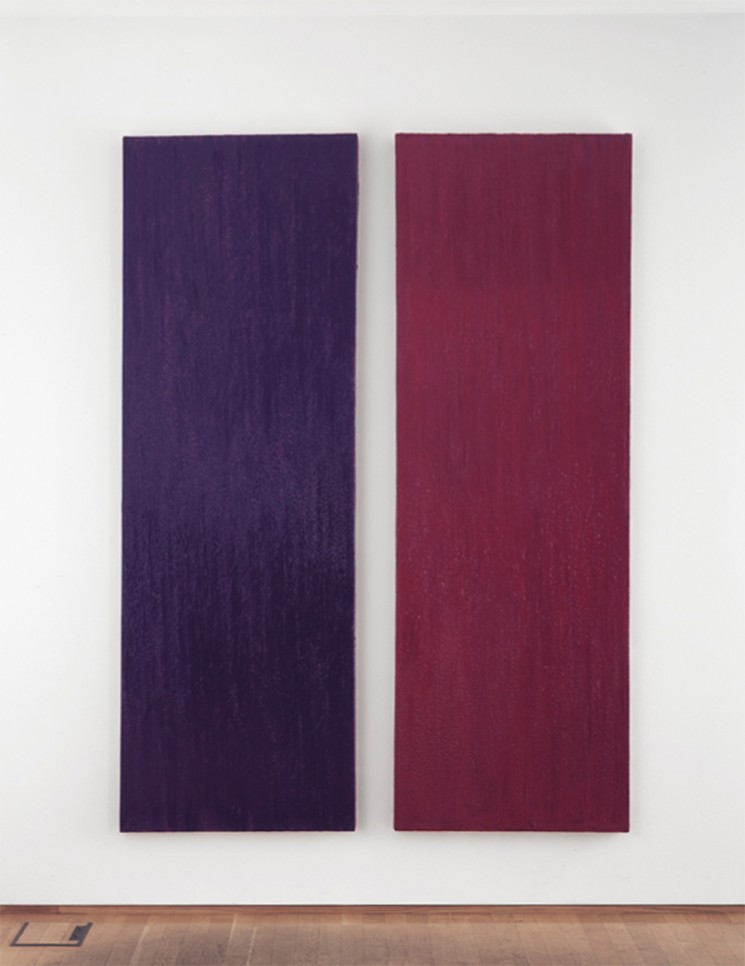Frederic Matys Thursz
Éloge aux mains Spectra I, Focillion Éloge aux mains II

“Paint will outlive painting. Paint has precedence. I believe in paint. Was another painting necessary after Las Meninas?“
Frederic Matys Thursz (1930-1992) is considered one of the most important representatives of post-modern colour painting of the 1980s in Europe as well as the United States. While his early work was still strongly influenced by the Ecole de Paris and Abstract Expressionism he found his own ”radical” style in the 1970s.
He was always well aware of his painterly traditions and called vastly differing positions such as the windows (French: vitraux) of the Chartres cathedral, the Isenheimer altar by Grünewald, Jean Fautrier or Mark Rothko patrons of his painting. In his main work he created large-sized, seemingly monochrome works in a kind of layer painting, which he created concentrating on the artistic principle of a radical reduction to colour and light, according to him “the totality of painting”.
At the same time he was presented at his first renowned exhibitions and in 1978 founded the group “Radical Painting” together with Jerry Zeniuk, Joseph Marioni, Günther Umberg as well as Marcia Hafif. Thursz‘ work did not gain growing recognition until the 1980s and 90s. In 1988 he was dedicated a retrospective at the Musée d‘Art Moderne in Staint-Etienne. His final presentation of his work was in 1992 at the documenta IX in Kassel, Germany. The artist died the same year.
In the large sized diptych ”Eloge aux Mains“ from 1987/90 Thursz implemented his artistic principle in what can be described as a sublime manner. In his search for the absolute colour or the autonomy of colour the artist experimented with different techniques and materials. In an almost alchemistic manner he used oils, waxes, resins, glue, varnishes and pigments. He described his approach as follows:
„It is chemistry, alchemy. To give the illusion of red I use purple and add green, which makes the red verge on violet. Then another layer of green and a passage of violet is needed. The result of these overlappings is a reddish glow. Then I add vermilion and the red becomes so deep that it is more red than real red.”
Size and materiality of the work as well as its heavily structured surface stand in contrast to this approach. Thursz often built his paintings over various years from uncountable isolated and fused layers of paint, mostly on the basis of pure pigment for the ground (Italian: imprimatura). He did not hesitate to maltreat the canvas with his hands, rugs or hot iron or to scratch or scuff the surface while creating his work. All layers of colour stand in contrary or complimentary relationship with each other, influence one another and differ regarding their thickness and texture. This serves to explain the special surface structure of his work and the fact that the superficial monochromic appearance is just seemingly so.
The result of this layer painting is not one definable colour but rather a sum of colours according to the light prism resulting from the interaction of rays of light with the various layers of colour. The paintings reflect light, shine it into the room and have a different appearance according to the current mood of the day. Light beomes a function of colour. Colour turns into light, is light.
Thursz turned both his maxims into reality. He gave colour never before known materiality and autonomy and provided his paintings with a luminosity, which shines beyond the borders of the painting. His works gain spaciousness and an aura in the Benjaminian sense. The artist furthermore directed the painterly process to the inside and provided his paintings with a sublime depth and transcendence by doing so. Thursz himself confirmed:
“Beyond the physicality of a painting there is a spirituality, a transcendence. For me, painting, is substance, its colour and its light can give a meaning to everything. There is no need for representation or abstraction.”